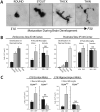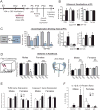Beyond infection - Maternal immune activation by environmental factors, microglial development, and relevance for autism spectrum disorders
- PMID: 28698032
- PMCID: PMC5723548
- DOI: 10.1016/j.expneurol.2017.07.002
Beyond infection - Maternal immune activation by environmental factors, microglial development, and relevance for autism spectrum disorders
Abstract
Immune molecules such as cytokines and chemokines and the cells that produce them within the brain, notably microglia, are critical for normal brain development. This recognition has in recent years led to the working hypothesis that inflammatory events during pregnancy, e.g. in response to infection, may disrupt the normal expression of immune molecules during critical stages of neural development and thereby contribute to the risk for neurodevelopmental disorders such as autism spectrum disorder (ASD). This hypothesis has in large part been shepherded by the work of Dr. Paul Patterson and colleagues, which has elegantly demonstrated that a single viral infection or injection of a viral mimetic to pregnant mice significantly and persistently impacts offspring immune and nervous system function, changes that underlie ASD-like behavioral dysfunction including social and communication deficits. Subsequent studies by many labs - in humans and in non-human animal models - have supported the hypothesis that ongoing disrupted immune molecule expression and/or neuroinflammation contributes to at least a significant subset of ASD. The heterogeneous clinical and biological phenotypes observed in ASD strongly suggest that in genetically susceptible individuals, environmental risk factors combine or synergize to create a tipping or threshold point for dysfunction. Importantly, animal studies showing a link between maternal immune activation (MIA) and ASD-like outcomes in offspring involve different species and diverse environmental factors associated with ASD in humans, beyond infection, including toxin exposures, maternal stress, and maternal obesity, all of which impact inflammatory or immune pathways. The goal of this review is to highlight the broader implications of Dr. Patterson's work for the field of autism, with a focus on the impact that MIA by diverse environmental factors has on fetal brain development, immune system development, and the pathophysiology of ASD.
Keywords: Air pollution; Developmental programming; Environmental toxins; Neurodevelopmental disorders.
Copyright © 2017 Elsevier Inc. All rights reserved.
Figures




References
-
- Ashwood P, Wakefield AJ. Immune activation of peripheral blood and mucosal CD3+ lymphocyte cytokine profiles in children with autism and gastrointestinal symptoms. Journal of neuroimmunology. 2006;173:126–134. - PubMed
-
- Ashwood P, Wills S, Van de Water J. The immune response in autism: a new frontier for autism research. J Leukoc Biol. 2006;80:1–15. - PubMed
-
- Atladottir HO, Thorsen P, Schendel DE, Ostergaard L, Lemcke S, Parner ET. Association of hospitalization for infection in childhood with diagnosis of autism spectrum disorders: a Danish cohort study. Archives of pediatrics & adolescent medicine. 2010;164:470–477. - PubMed
-
- Batinic B, Santrac A, Divovic B, Timic T, Stankovic T, Obradovic A, Joksimovic S, Savic MM. Lipopolysaccharide exposure during late embryogenesis results in diminished locomotor activity and amphetamine response in females and spatial cognition impairment in males in adult, but not adolescent rat offspring. Behavioural brain research. 2016;299:72–80. - PubMed
Publication types
MeSH terms
Grants and funding
LinkOut - more resources
Full Text Sources
Other Literature Sources
Medical

